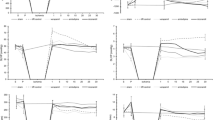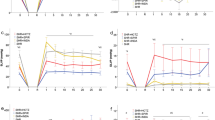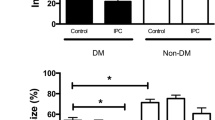Abstract
Brief episodes of myocardial ischemia-reperfusion applied early in reperfusion may attenuate the reperfusion injury, strategy called ischemic postconditioning (IPO). Our objective was to examine the effects of IPO compared with ischemic preconditioning (IP) on postischemic myocardial dysfunction in spontaneously hypertensive rats (SHR). Isolated hearts from SHR and normotensive WKY rats were subjected to the following protocols: (1) Ischemic control (IC): global ischemia 20 min (GI20) and reperfusion 30 min (R). (2) IPO: three cycles of R30sec–IG30sec at the onset of R; (3) IP: a cycle of IG5–R10 previous to GI20, (4) IPO in the presence of chelerythrine, an inhibitor of protein kinase C (PKC). Systolic and diastolic function were assessed through developed pressure (LVDP) and end diastolic pressure (LVEDP), respectively. Lipid peroxidation was estimated by thiobarbituric reactive substance (TBARS) concentration. IPO significantly improved postischemic dysfunction. At the end of R, LVDP recovered to 87 ± 7% in WKY and 94 ± 7% in SHR vs. 55 ± 11% and 58 ± 12% in IC hearts. LVEDP reached values of 24 ± 6 mmHg for WKY and 24 ± 3 mmHg for SHR vs. 40 ± 8 and 42 ± 5 mmHg in IC hearts. Similar protection was achieved by IP. TBARS contents of SHR hearts were significantly diminished by IP and IPO. PKC inhibition aborted the protection of myocardial function and attenuated the diminution of lipid peroxidation conferred by IPO. These data show that IPO was as effective as IP in improving the postischemic dysfunction of hearts from SHR hearts, and that this cardioprotection appears to be associated with a diminution of ROS-induced damage involving the PKC activation.
Similar content being viewed by others
References
Murry CE, Jennings RB, Reimer KA (1986) Preconditioning with ischemia: a delay of lethal cell injury in ischemic myocardium. Circulation 74: 1124–1136
Yellon DM, Downey JM (2003) Preconditioning the myocardium: from cellular physiology to clinical cardiology. Physiol Rev 83: 1113–1151
Vegh A, Komori S, Szekeres L (1992) Antiarrhythmic effects of preconditioning in anaesthetised dogs and rats. Cardiovasc Res 26: 487–495
Kloner RA, Jennings RB (2001) Consequences of brief ischemia: stunning, preconditioning, and their clinical implications: part 1. Circulation 104: 2981–2989
Mosca SM, Gelpi RJ, Milei J, Fernandez Alonso G, Cingolani HE (1998) Is stunning prevented by ischemic preconditioning? Mol Cell Biochem 186: 123–129
Zhao Z-Q, Corvera JS, Halkos ME Kerendi F, Wang NP, Guyton RA, Vinten-Johansen J (2003) Inhibition of myocardial injury by ischemic postconditioning during reperfusion: comparison with ischemic preconditioning. Am J Physiol Heart Circ Physiol 285: 579–588
Kin H, Zhao ZQ, Sun HY, Wang NP, Corvera JS, Halkos ME, Kerendi F, Guyton RA, Vinten-Johansen J (2004) Postconditioning attenuates myocardial ischemia-reperfusion injury by inhibiting events in the early minutes of reperfusion. Cardiovasc Res 62: 74–85
Yang XM, Proctor JB, Cui L, Krieg T, Downey JM, Cohen MV (2004) Multiple, brief coronary occlusions during early reperfusion protect rabbit hearts by targeting cell signaling pathways. J Am Coll Cardiol 44: 1103–1110
Tsang A, Hausenloy DJ, Mocanu MM, Yellon DM (2004) Postconditioning: a form of “modified reperfusion” protects the myocardium by activating the phosphatidylinositol 3-kinase-Akt pathway. Circ Res 95: 230–232
Mitchell MB, Meng X, Ao L, Brown JM, Harken AH, Banerjee A (1995) Preconditioning of isolated rat heart is mediated by protein kinase C. Circ Res 76: 73–81
Ping P, Takano H, Zhang J, Tang XL, Qiu Y, Li RC, Banerjee S, Dawn B, Balafonova Z, Bolli R (1998) Isoform-selective activation of protein kinase C by nitric oxide in the heart of conscious rabbits: a signaling mechanism for both nitric oxide-induced and ischemia-induced preconditioning. Circ Res 84: 587–604
Kawamura S, Yoshida K, Miura T, Mizukami Y, Matsuzaki M (1998) Ischemic preconditioning translocates PKC-δ and -ε, which mediate functional protection in isolated rat heart. Am J Physiol 275: H2266–H2271
Philipp S, Yang XM, Cui L, Davis AM, Downey JM, Cohen MV (2006) Postconditioning protects rabbit hearts through a protein kinase C-adenosine A(2b) receptor cascade. Cardiovasc Res 70: 308–314
Buñag RA (1973) Validation in awake rats of tail cuff method for measuring systolic pressure. J Appl Physiol 34: 279–282
Buege JA, Aust SD (1978) Microsomal lipid peroxidation. Methods Enzymol 52: 302–309
Gelpi RJ, Morales C, Cohen MV, Downey JM (2002) Xanthine oxidase contributes to preconditioning’s preservation of left ventricular developed pressure in isolated rat heart: developed pressure may not be an appropriate end-point for studies of preconditioning. Basic Res Cardiol 97: 40–46
Grover GJ, Dzwonczyk S, Monticello TM (1996) Comparative cardioprotective efects of cromakalim and diltiazen in ischemic hypertrophied rat hearts. Am J Physiol 270: H174–H182
Hoffmeister HM, Ströbele M, Beyer ME , Kazmaier S, Fischer M, Bassler A, Seipel L (1998) Inotropic response of stunned hypertrophied myocardium: responsiveness of hypertrophied and normal postischemic isolated rat hearts to calcium and dopamine stimulation. Cardiovasc Res 38: 149–157
Snoeckx LH, van der Vusse GJ, Coumans WA, Willemsen PH, Reneman RS (1993) Differences in ischaemia tolerance between hyperthrophied hearts of adult and aged spontaneously hypertensive hearts. Cardiovasc Res 27: 874–881
Zhao Z-Q, Sung HY, Wang NP, Kerendi F, Guyton RA, Vinten-Johansen J (2003) Hypoxic post-onditioning reduces cardiomyocyte loss by inhibiting reactive oxygen species-triggered mitochondrial calcium overload. Circulation 108(suppl IV): 174 2003
Penna C, Rastaldo R, Mancardi D, Raimondo S, Cappello S, Gattullo D, Losano G, Pagliaro P (2006) Post-conditioning induced cardioprotection requires signaling through a redox-sensitive mechanism, mitochondrial ATP-sensitive K(+) channel and protein kinase C activation. Basic Res Cardiol 101(2): 180–189
Hausenloy DJ, Yellon DM (2004) New directions for protecting the heart against ischaemia-reperfusion injury targeting the reperfusion injury salvage kinase (RISK)-pathway. Cardiovasc Res 61: 448–460
Le Good JA, Ziegler WH, Parekh DB, Alessi DR, Cohen P, Parker PJ (1998) Protein kinase C isotypes controlled by phosphoinositide 3-kinase through the protein kinase PDK1. Science 281: 2042–2145
Toker A, Meyer M, Reddy KK, Falck JR, Aneja R, Aneja S, Parra A, Burns DJ, Ballas LM, Cantley LC (1994) Activation of protein kinase C family members by the novel polyphosphoinositides PtdIns-3, 4-P2 and PtdIns-3,4,5-P3. J Biol Chem 269: 32358–32367
Sabri A, Steinberg SF (2003) Protein kinase C isoform-selective signals that lead to cardiac hypertrophy and the progression of heart failure. Mol Cell Biochem 251: 97–101
Dorn GW, Force T (2005) Protein kinase cascades in the regulation of cardiac hypertrophy. J Clin Invest 115: 527–537
Author information
Authors and Affiliations
Corresponding author
Rights and permissions
About this article
Cite this article
Fantinelli, J.C., Mosca, S.M. Comparative effects of ischemic pre and postconditioning on ischemia-reperfusion injury in spontaneously hypertensive rats (SHR). Mol Cell Biochem 296, 45–51 (2007). https://doi.org/10.1007/s11010-006-9296-2
Received:
Accepted:
Published:
Issue Date:
DOI: https://doi.org/10.1007/s11010-006-9296-2




